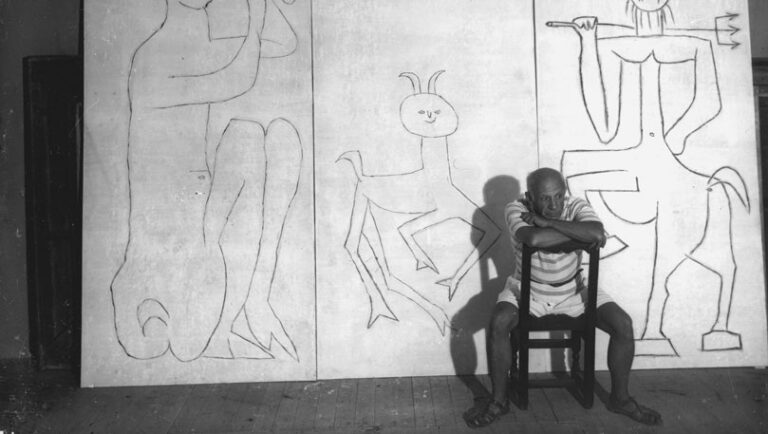Most of us don’t escape the obligation of some kind of quarantine in these corona-driven times. Social distancing and isolation are keywords in press. It gives us an unexpected time for reflection. But what about artists? Aren’t they alone most of the time, building on their creations? Some even had a preference in working in solitude or expressed their isolation in their works. Let’s check five artists who performed at their best alone.
Great and lesser-known artists often strive for idealism and keep away from compromises as much as possible. For those who fully want to focus themselves on their work, it is almost a necessity to empty their mind completely, and then start working and have their mind refilled with their creative inputs. They engage the so-called creative tunnel vision. Good for them, let them chase their ideals. However, for their close loved ones, it might be less fun. Especially when your in-house artist is in a rage, such as we will see was the case with Picasso. They are kept out of the artist environment and can only hope to share the artist excitement after the labor of art has been done.
These Artists Performed at Their Best Alone
Yayoi Kusama: Alone in an Infinite Cosmos of Polka Dots
This Japanese artist is probably best known for her sculptures and immersive installations. On top of that, she is also a painter, a performance artist, fashion designer, filmmaker, poet and novelist.
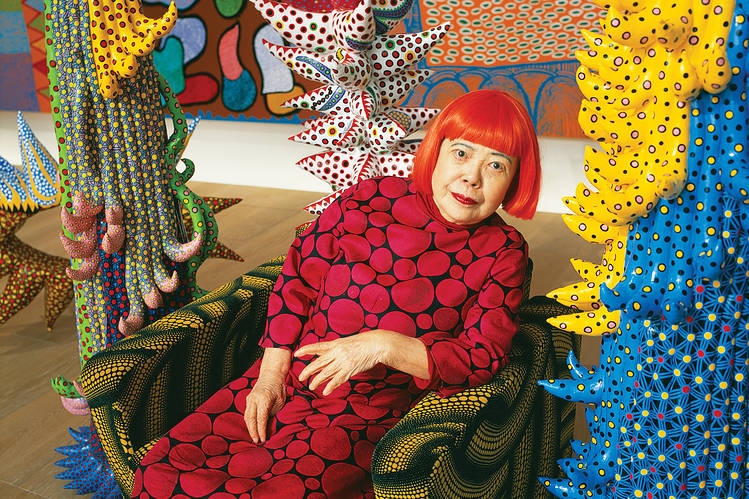
Coronavirus, Go away!
Her latest work only dates from a few days ago. Kusama wrote a poem about the Corona/COVID-19 pandemic. In her poem, she gives hope to all of us and shows her fighting spirit.
“I say, Disappear from this earth.”
Yayoi Kusama
Kusama has a unique style and a very particular visual language. A returning motif in her work are polka dots. She takes these dots to a micro as well as a macro level. The Earth is only one small polka dot among a million stars in the cosmos. She creates Infinity Rooms to evoke the idea of an infinite universe. In her installations, she merges architecture and art in order to give her spectators the feeling of her loneliness. In fact, she does research on how a person’s position in space is seen. On one side, from the person’s own perspective and on the other side, from the outside, when you’re looking at your fellow spectators. Therefore, she used infinity mirrors to enlarge the experience and take the viewers on an endless repetition of their own reflection.
That’s a perspective to make you feel immensely small and maybe lost in such an immense space as the cosmos. She translates the emotion of being lost in loneliness. It is a main driver for her. She’s afraid of being alone and the older she gets (she is now 91 years old), the lonelier she fears she will be.
Kusama’s Hallucinations
Her fear of being lonely might have begun when she began to experience hallucinations when she was 10 years old. She described her visions as flashes of light, auras, or dense fields of dots. This pattern would stay with her and inspire her to pursue a life achievement in art.
Later, in her forties, she would relive these hallucinations, probably triggered by the death of her partner Joseph Cornell, an American surrealist. She started writing surrealistic stories and poetry, which she finished in Seiwa mental hospital in Japan, where her studio is installed. Kusama is actually still residing in this mental hospital.
The Narcissus Garden
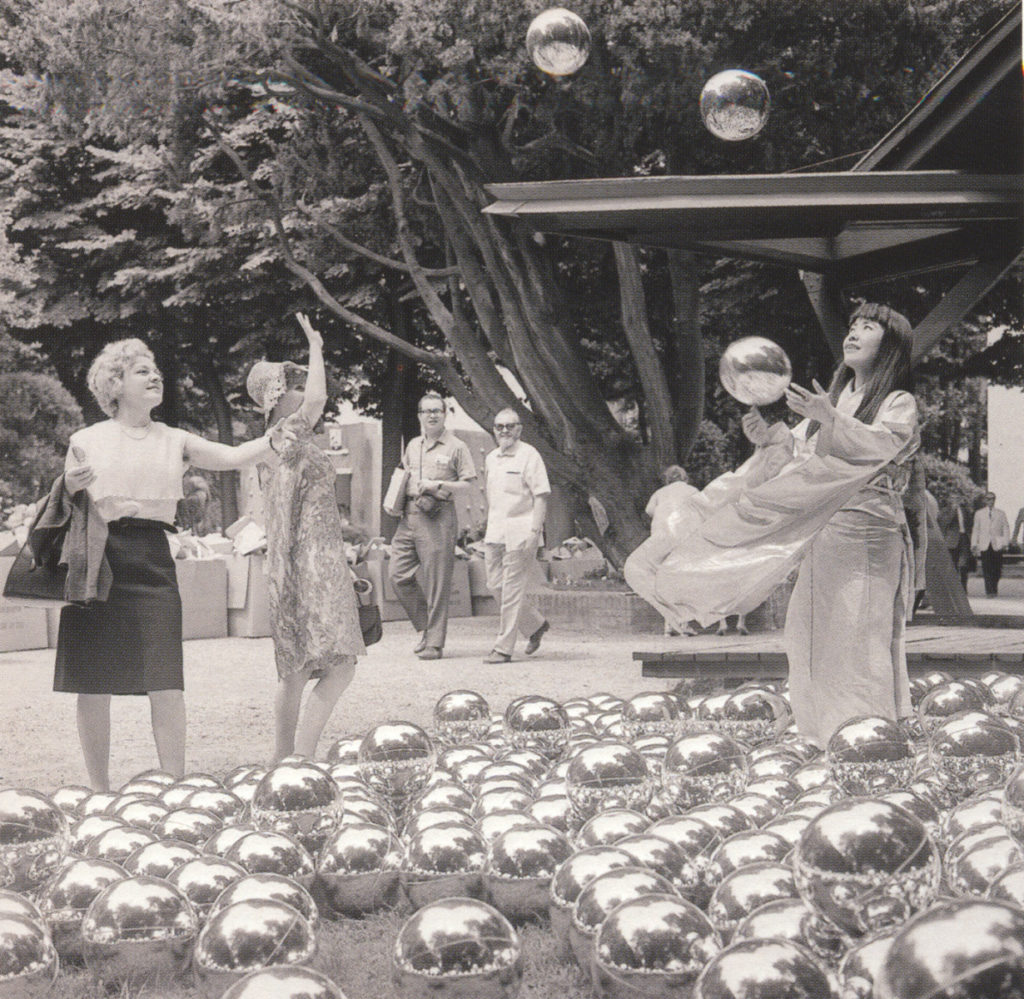
In her installation Narcissus Garden at the Venice Biennale in 1966, she placed thousands of mirrored balls in a landscape. The viewers were reflected in each of the balls and are an alternative for her Infinity Rooms. Kusama, dressed in a golden kimono, sold the plastic balls for $2 each, so that you could take your own little cosmos home. She has repeated this installation on many occasions, up until 2018. The numerous people who have visited her installations and have shared pictures of it on social media contributed to her private expanding cosmos.
In the early 2000s, she filled spacious rooms with lights and mirrors to give visitors a more intense experience of cosmos and invited them to reflect on existential matters. Many felt an out-of-body experience in these boundless spaces.
Pablo Picasso: All by Himself in His Studio
Time for Fun
The pictures and stories around the famous Picasso show a cheerful and vital person, eager to spend pleasant times surrounded by others. When he was 17 years old, he moved with his parents to Barcelona and frequented the café Els Quatre Gats often. The café wasn’t just a place to meet friends, but it was his first experience to show the world about his art. In 1900, he held his first exhibition of charcoal and watercolor portraits in the main room and designed the poster that was used as the cover of the house menu. Today, Els Quatre Gats is still open as a restaurant and café.
Later, in Paris, he met his friends in the Montmartre and Montparnasse Quarters. He discussed art and other topics with other artists such as Guillaume Apollinaire, André Breton and his financier and collector Gertrude Stein.
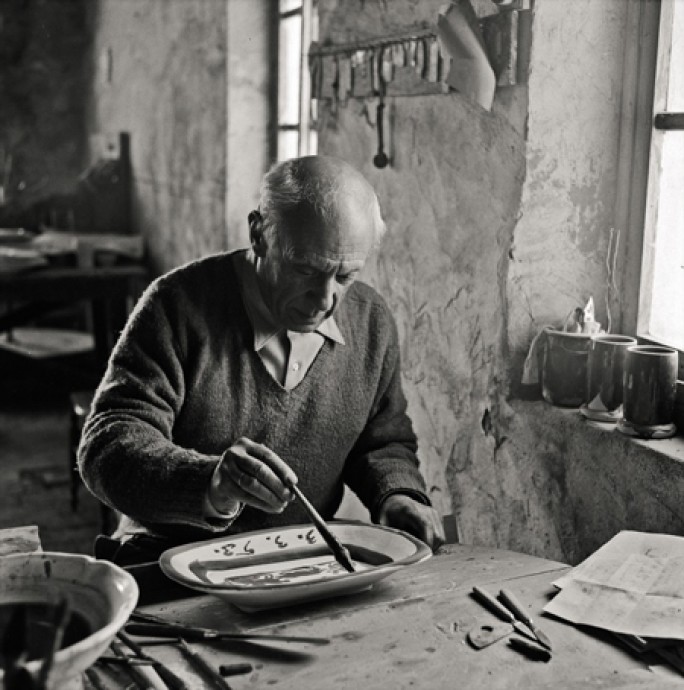
Time for Work
A very social person, that Picasso, you would say. But that was only up until the moment he enters his atelier. Time to work, time to reconnect with himself. He worked in solitude while in his studio and he didn’t really allow anybody to interfere with him. Moreover, he had his furious moments too, so I guess it was for the best to leave the master alone with his work.
In 1952, Picasso realized that he wasn’t a great painter such as Goya, Rembrandt, Giotto or Titian, but more a public entertainer. At least, these were his own words. He said that he felt alone. He was in his seventies and had already painted an enormous oeuvre. Some years before, he turned more and more to ceramics in order to broaden his skills and to be with his new lover Jacqueline Roque, who worked in a pottery atelier in Vallauris, France.
“Without great solitude, no serious work is possible.”
Pablo Picasso
Francis Bacon: In-between Isolation and Bursting Nightlife
Francis Bacon, the painter who shared his name with the English 16th century philosopher, is most famous for his 1953 Study After Velazquez’s Portrait of Pope Innocent X, probably the most resonant cry in the history of modern art. With this painting, he’s offered a seat next to the other existential works such as Edvard Munch’s The Cry of 1895 and the grieving woman of Picasso’s Guernica of 1936.
A lonely childhood, an asthmatic health condition preventing him from going to school, and on top of that, a shy character. These ingredients won’t make a very extrovert person, that’s for sure. That’s what happened in the early life of the Irish-born painter known as Bacon, who was known for his distorted and emotionally loaded works. In fact, the only people he frequented as a child was his close family and the priest who gave him schooling at his home. Other people frightened him at that time. That might explain the strange portraits that he painted during his lifetime.
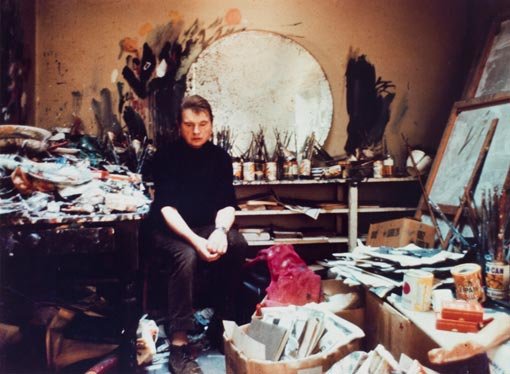
A Double Personality
However, there is more than that. It would be much too limited to claim that Bacon was a shy and disturbed mind. You could say that he had a double personality. He had this desire to step out of normality but, at the same time, he was very cynical.
It began at the age of 16, when Bacon was discovered by his father dressing in his mother’s underwear and was sent away from home. He was discovering his homosexuality and, while living alone in London, he liked to dress-up, wear make-up and roam in gentlemen’s clubs.
Feeling strange to himself, he was lingering between the sparkling nightlife and his still introvert personality. I suppose that he found some rest before the canvas. He stood there alone, however always accompanied by his imagination.
Champagne @ Night
Most days, he worked alone holding a disciplined routine. The mornings were dedicated to his art. Working alone, in silence, in his studio from 6 a.m. until 2 p.m., that was the lone part of the day. Once he left his canvas, he would turn into a well-spoken visitor of expensive restaurants and Soho drinking clubs, where he met artists, writers and other bohemians. Oysters, champagne and a growing crowd of admirers were part of this second part of the day, and night.
A popular guy, you might say, but don’t be mistaken by his charm and generosity. He allowed nothing or no one to get in the way of his work and was often selfish, demanding and extremely cruel. Two of his former partners committed suicide.
Picasso as a Soulmate
In this perspective, Bacon looks a lot like Picasso, who also went from one lover to the next, leaving behind two ex-partners who also committed suicide.
Similar personalities often share an interest. That was again the case for Bacon and Picasso. Bacon admired Picasso’s surrealist beach scenes that he had painted in the early 1930s. His interest went especially to the biomorph persons on the beach. That means that the painter uses a shape resembling the depicted. This would be the start of Bacon’s new style. A few decades later, Bacon would paint deformed faces in his portraits. But while Picasso’s love for life is clearly reflected in his biomorphs, Bacon’s are quite sinister, as in Three Studies for Figures at the Base of a Crucifixion, that he finished in 1944.
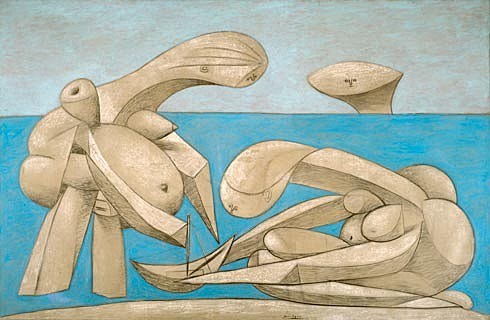
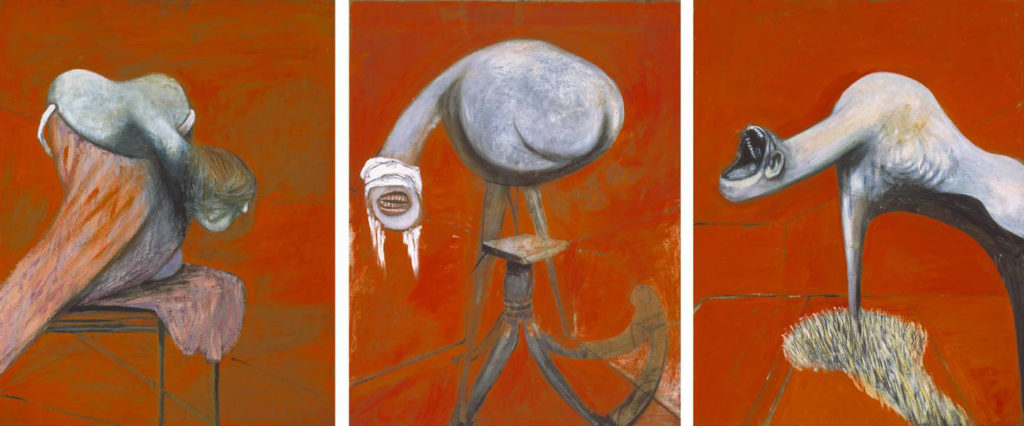
Ellsworth Kelly: How Loneliness Brings the Best out of Someone
Like Francis Bacon, Kelly also was a shy person who suffered from childhood illness. His mother and grandmother introduced him to bird-watching at the age of five to ensure he had plenty of fresh air. This would be the basics for his latter art career: the love of silence and the observation of nature. During his lifetime, he remained a bird-watcher and was inspired by the colors of outside nature (leaves, the woods, etc.).
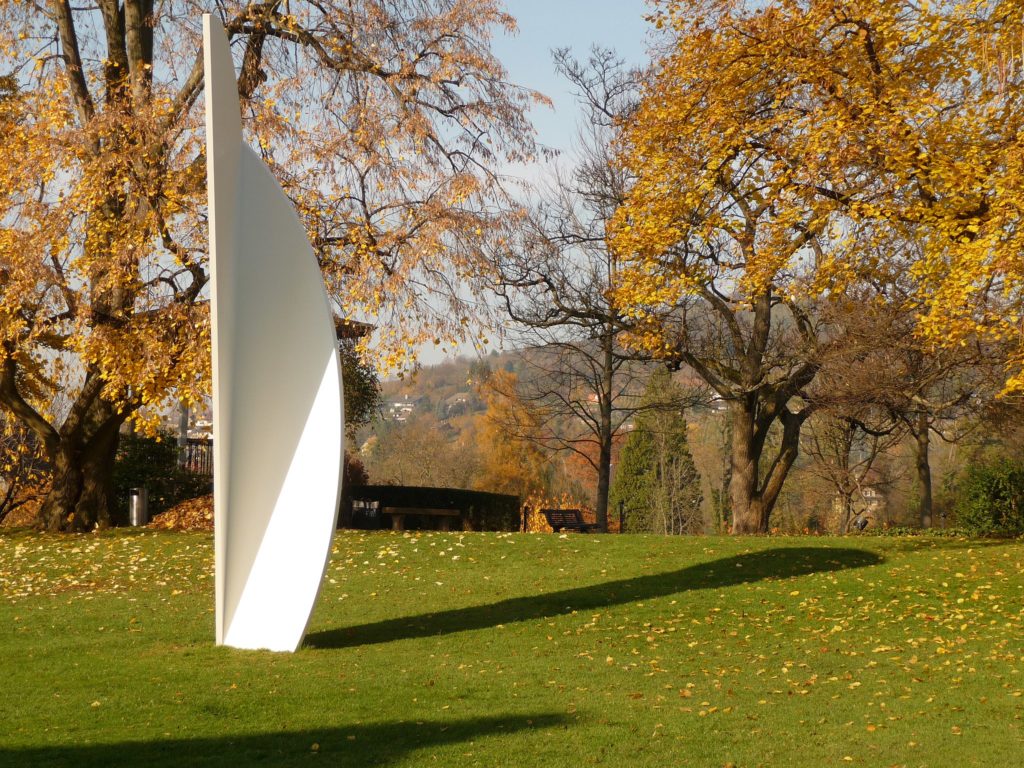
An American with European Influences
Kelly is an all-round artist who mixed his American style with European influences. As a sculpture, painter and printmaker, he covered minimalism and color field painting.
To explain his European influence, we need to go back to his wartime service where he served in a special unit. It’s quite particular: his team designed inflatable dummies of tanks as a camouflage to detract the Germans’ attention from the real troops. After the war, he went back to complete his courses at the art school in Boston but returned to Paris in 1948 and stayed there for the next six years. There, he picked up his admiration for his three favorite European artists: Jean Arp, Brancusi and Piet Mondriaan. The influence of the latter becomes very clear looking at his famous Colors for a Large Wall.
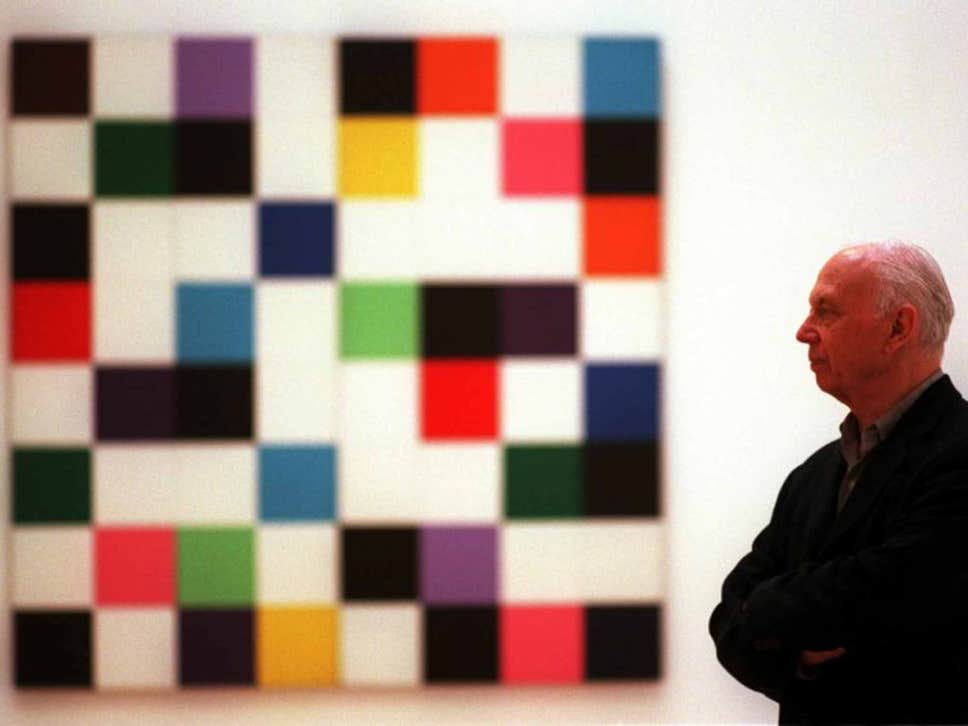
A Stranger
A strange fact during his time in France was that he never attempted to learn French. He could not speak nor read it. That made him very much a loner. During all this time, he focused on himself. He was trying to find himself and consequently remained at a social distant. That didn’t bother him because he liked being a stranger, as he claimed in a New York Times interview in 1996.
Also, in the clarification of his artworks, he wasn’t the man who would talk and talk for hours. He didn’t comment on his pieces too much and left them simply for what they are. Only occasionally, he felt the necessity to defend his art when critics said that his art is very accessible and simple. Understandably, he didn’t like the word ‘simple.’ He preferred the word ‘easy.’ What he really meant was that he wanted the viewers to forget about the technique and his sweat.
Frida Kahlo’s Tragedy
We end this list of artists with a woman whose life you could describe as a chain of misfortune. Unlike the previously mentioned artists, Frida Kahlo was forced to be isolated due to external factors in her life. Luckily for her current admirers, it gave her the inspiration for her art. The paintings she made are no pretty pictures, but reflect her painful state of being, often with respect to Mexican traditions.
A Difficult Life
Nobody will envy her for her personal life. To begin with, she had a tense relationship with her fanatically religious mother. At the age of six, she had polio, which left her with one leg shorter than the other. The illness forced her to be isolated for several months. Kahlo experienced a small glimpse of light by the care and attention she received from her father, a photographer. He initiated her in photography, and she helped him in his studio.
Despite this positive note, a couple of years later, fate struck again when she was involved in a bus accident. Kahlo was badly hurt: she fractured her spine and a leg, crushed a foot and spent almost 2 years in bed to recover. She would take these injuries with her throughout her life, undergoing operations and wearing supportive corsets from steel, leather and plaster. On top of that, at a later age, she had a chronic infection on her hand, was treated for syphilis and become depressive after her father’s death. Her marriage with the famous painter Diego Rivera wasn’t filled with joy, either. A life hardly bearable.
The combination of all these unfortunate events placed her in a solitaire position. That’s the reason why she has portrayed herself so often alone and, on some occasions, lying in a bed. Far away from the company of other figures.
Two Kahlos, Two Bodies
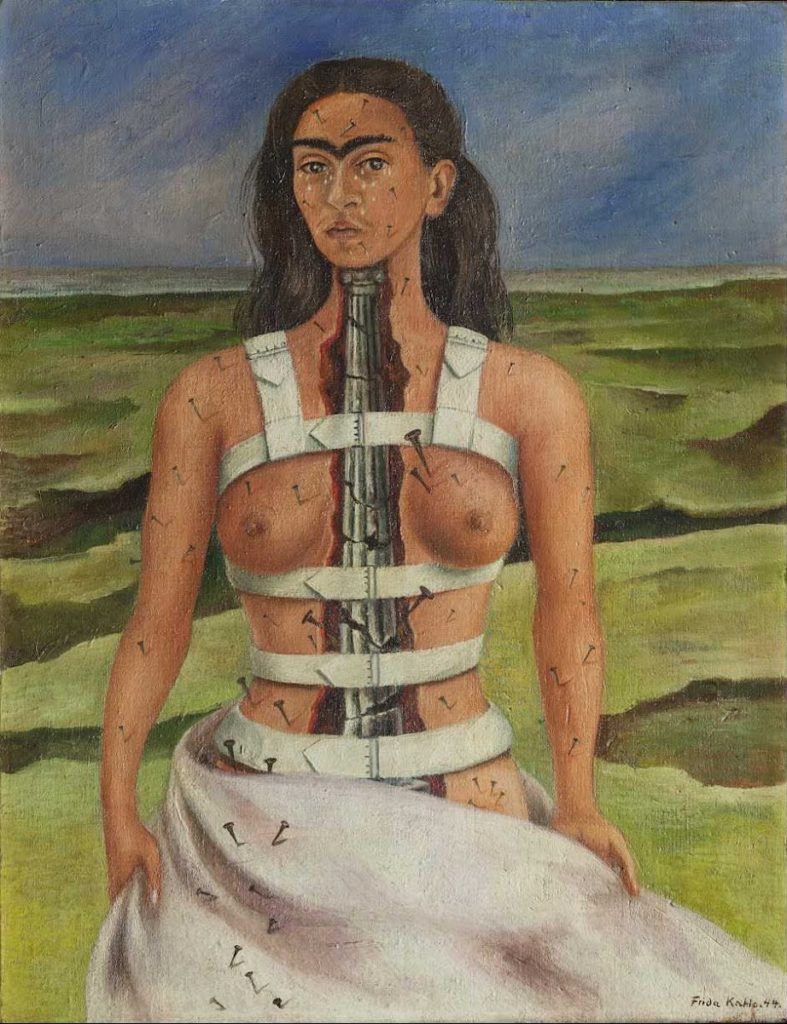
Another way of depicting her pain was to represent herself as a double woman, as an artist but also as someone caved in a broken body. In her 1944 painting The Broken Column, she presented herself as a fragile body full of pain and held together with a metal corset. Her face looks very sensual and taken care of. She looks right at you and holds her head straight up, as if she’s up to the challenge of facing her horrible physical condition. But on the other hand, tears are rolling from her cheeks and she stands in the middle of an isolated dessert. This painting symbolizes her life.
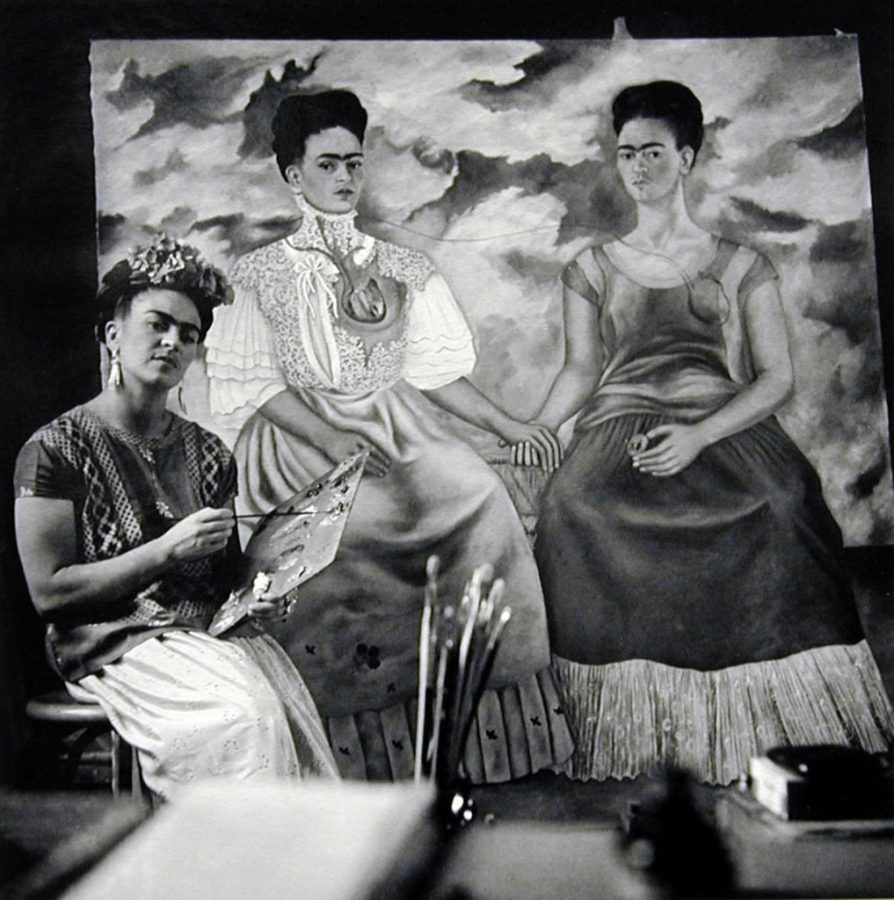
Born to a German Hungarian-Jewish father and a mother of Spanish and Mexican Indian descent, she painted herself twice in The Two Fridas. In this painting she saw herself as two women. The one in white clothes represents the European Kahlo, while the colorfully dressed one symbolizes her Mexican identity. Also, in real life, she began wearing traditional Mexican peasant long skirts. As in all her other paintings, her personal life is embodied in these two figures. You can see the heart over her clothes, both connected to each other, as her hands are. The Mexican heart looks whole while the other is torn open and blood spills over the contrasting white dress.
In the period in which she painted this work, many Spaniards exiled in Mexico because of the Spanish civil war. That might have inspired her also to do this work.
If you enjoyed “These Artists Performed at Their Best Alone,” you may want to read:
